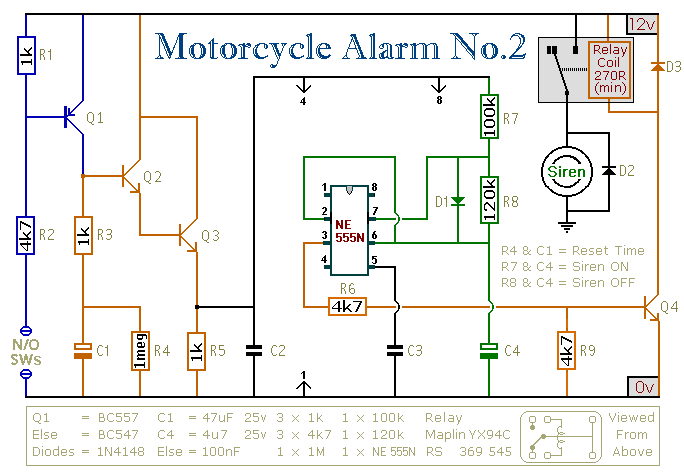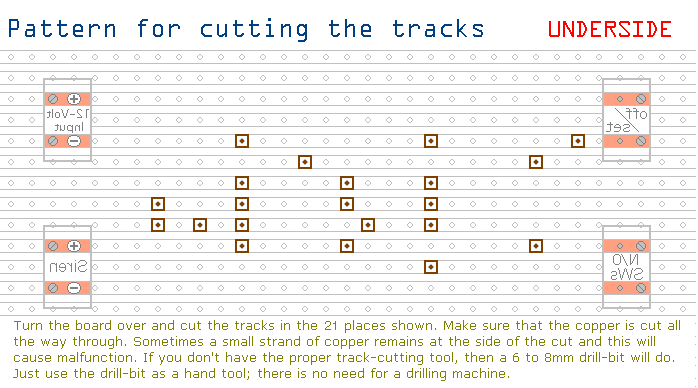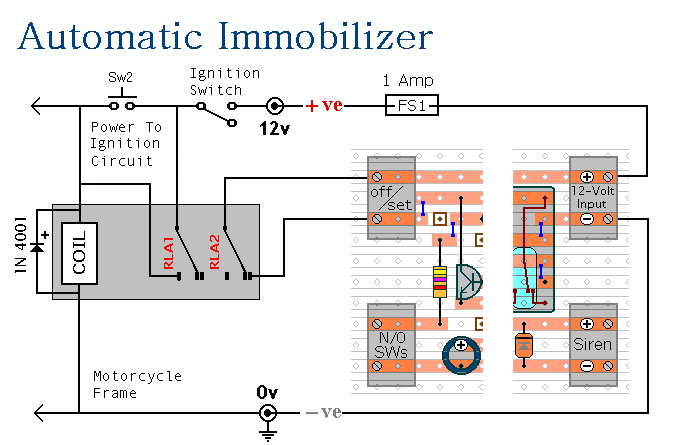Motorcycle Alarm Number 2
Description:This circuit features an intermittent siren output and automatic reset. It can be operated manually using a key-switch or a hidden switch; but it can also be wired to set itself automatically when you turn-off the ignition. By adding external relays you can immobilize the bike, flash the lights etc. Ron has used my Asymmetric Timer as the basis for his design.

Notes:
Any number of normally-open switches may be used. Fit "tilt" switches that close when the steering is moved or when the bike is lifted off its side-stand or pushed forward off its centre-stand. Use micro-switches to protect removable panels and the lids of panniers etc.
Once activated, the rate at which the siren switches on and off is controlled by R7, R8 & C4. For example, increasing R7 will make the sound period longer; while increasing R8 gives longer silent periods.
While at least one switch remains closed the siren will sound. About one minutes after all of the switches have been opened, the alarm will reset. How long it takes to switch off depends on the characteristics of the actual components used. You can adjust the time to suit your requirements by changing the value of R4 and/or C1.

The circuit is designed to use an electronic Siren drawing 300 to 400mA. It's not usually a good idea to use the bike's own Horn because it can be easily located and disconnected. However, if you choose to use the Horn, remember that the alarm relay is too small to carry the necessary current. Connect the coil of a suitably rated relay to the "Siren" output. This can then be used to sound the Horn, flash the lights etc.

The Support material for this alarm includes a detailed guide to the construction of the circuit-board, a parts list, a complete circuit description and more. The circuit board and switches must be protected from the elements. Dampness or condensation will cause malfunction. The components are all drawn lying flat on the board - but those connected between close or adjacent tracks are mounted standing upright. The links are bare copper wire on the component side. Two of the links must be fitted before the IC. A more detailed guide to the board's construction and a circuit description are available on request.
Connect a 1-amp in-line fuse AS CLOSE AS POSSIBLE to your power source. This is VERY IMPORTANT. The fuse is there to protect the wiring - not the alarm. Exactly how the system is fitted will depend on the make of your particular machine - so I'm unable to provide any further help or advice in this regard.
You can use a key-switch or a hidden switch to set the alarm - or you could use the normally-closed contacts of a small relay. Wire the relay coil so that it's energized while the ignition is on. Then every time you turn the ignition off - the alarm will set itself. The quiescent (standby) current is virtually zero - so there is no drain on the battery.
Add an Automatic Immobilizer.

Before fitting this or any other immobilizer to your bike, carefully consider both the safety implications of its possible failure - and the legal consequences of installing a device that could cause an accident.
If you decide to proceed, you will need to use the highest standard of materials and workmanship. Remember that the relay MUST be large enough to handle the current required by your ignition system. Choose one specifically designed for automobiles - it will be protected against the elements and will give the best long-term reliability. You don't want it to let you down on a cold wet night - or worse still - in fast moving traffic!!! Please note that I am UNABLE to help any further with either the choice of a suitable relay - or with advice on its installation.
When you turn-off the ignition, the relay will de-energize and the first set of contacts (RLA1) will break the ignition circuit - automatically immobilizing the bike. The second set of contacts (RLA2) will turn-on the alarm.
When the ignition is switched on again the relay will not energize. The bike's ignition circuit will remain broken; and the alarm will continue to protect the machine. You must press Sw2 to energize the relay. It then latches itself on using the first set of contacts (RLA1). The same set of contacts completes the connection to the ignition circuit; while the second set of contacts (RLA2) opens and switches off the alarm.
The design has a number of advantages. It operates automatically when you turn-off the ignition - so there's no need to remember to activate it. The relay uses no current while the ignition is off - so there's no drain on the battery. To de-activate it you'll need to have the ignition key and you'll need to know the whereabouts of the push-switch. For extra security Sw2 could be key-operated.
Source:www.zen22142.zen.co.uk






